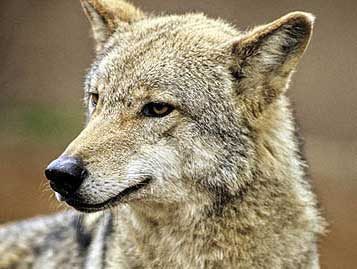Coyote

The coyote has a reputation of being a sneaky thief. This comes from stealing the livestock of farmers and perhaps from their slinking trot, shifty-eyed body language and nocturnal activities.
Coyotes can be found throughout the North American continent. Unlike the wolf, with roots in Eurasia, the coyote evolved entirely in the Americas. A coyote can live in both mountainous terrain, in the desert or even suburbs and cities. The coyote found in the desert is scrawny compared to its mountain cousins. The desert coyote weighs in at a paltry 20 lbs (9 kg) while the mountain coyote can be up to 50 lbs (23 kg). The largest on record weighed 75 lbs (34 kg).
A coyote can be very vocal, howling to express its need for companionship, and to let everyone know what its territorial expectations are. The scientific name for the coyote means “barking dog.” The nighttime songs of the coyote have also contributed to its status in legend and folklore as the howling and high-pitch yips can be a little unnerving. In Native American mythology the coyote is commonly portrayed as a trickster. Traits commonly attributed to them in legends and pop culture include inventiveness, evasiveness and mischievousness.

The coyote is a very adaptable animal and can change its breeding, feeding and living habits rather quickly to accommodate survival. As part of their unusual ability to adapt, they can mate with both wolves and domestic dogs and have six to twelve pups in their litter, twice a year. The pup’s survival rate is pretty low, about 12 percent, so that offsets the large litters and twice a year birthing. Many modern-day coyotes may have some mix of wolf ancestry.
The coyote can leap over tall fences in a single bound to escape danger or seaking prey. This seems to irritate ranchers who are trying to keep them away from livestock. They run at a top speed of about 40 mph (65 kph).
A coyote is something less than a connoisseur when it comes to food. They will eat meat and fish, sometimes fresh sometimes rotted, any old varmint will do. They also will eat all sorts of vegetable matter, preferring sweet fruit. This is another factor that does not endear them to farmers whose crops are picked through by a coyote. A coyote will typically hunt alone or in pairs for small mammals. They will also team up if need be to take down something larger, like a young dear or a small horse. They do eat livestock, and even domestic pets like cats and dogs, if they are given the opportunity because they are opportunistic hunters but really do not have a preference. They are also very persistent hunters and may track and attack prey for a day or more.
